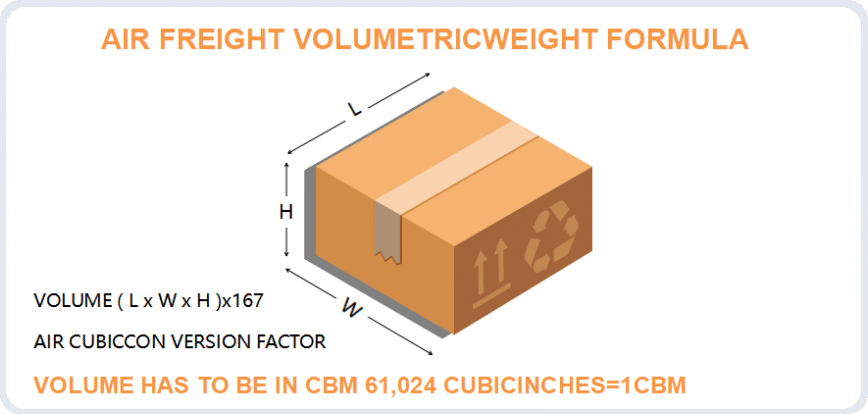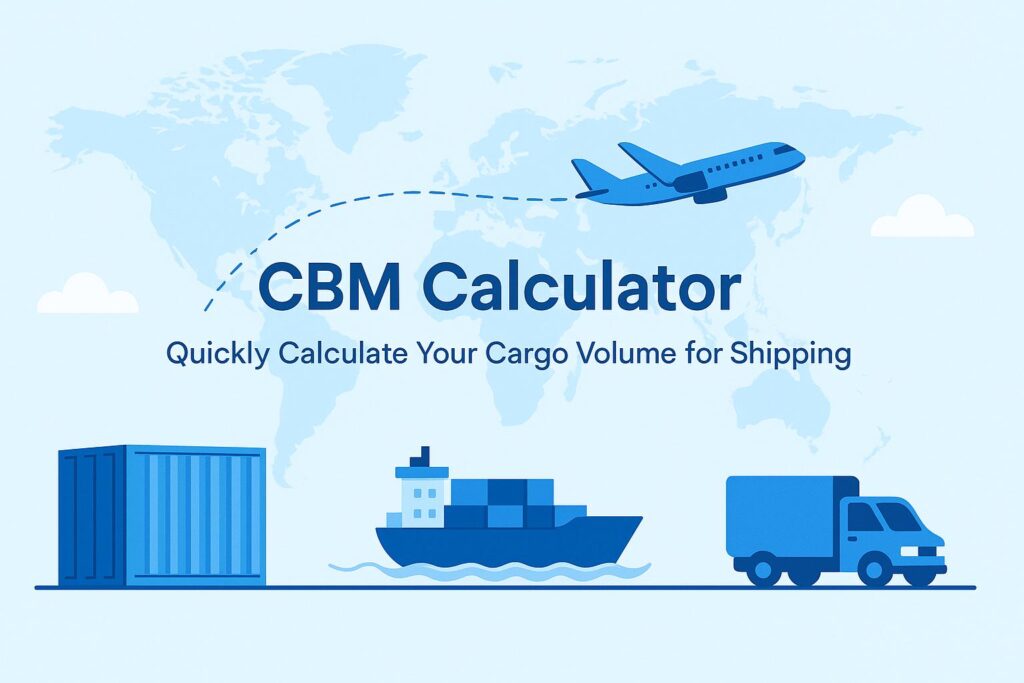Calculate your cargo volume instantly with our free CBM Calculator. Whether you are shipping goods by ocean freight, air freight, or express courier, knowing your shipment volume in cubic meters is essential for accurate freight cost estimation. Use our user-friendly interface to input your cargo dimensions and get immediate results. Our tool is designed for international trade professionals, shipping companies, and freight forwarders who need quick and precise volume calculations.
📦 CBM & Dimensional Weight Calculator
Use the calculator below to estimate your container volume and compare rates across carriers.
Quickly calculate your shipping CBM and freight volume with our free tool. Input your cargo dimensions below to get instant results!
What Is CBM and Why It Matters in Shipping
CBM, short for Cubic Meter, is a standard unit used to measure the volume of cargo. It defines the amount of space a shipment occupies, crucial for determining freight charges in global shipping. One CBM represents a cube measuring one meter on each side — making it a universal measurement across shipping companies and international trade.
In CBM shipping, understanding your cargo’s cubic volume is essential. Shipping costs often depend more on the space your goods occupy rather than their weight. Whether you’re dealing with air freight, ocean freight, or courier services, knowing your cargo’s CBM ensures accurate freight volume calculation and helps optimize your shipping process.
CBM plays a major role in efficient space utilization within containers and directly impacts shipment costs, container space allocation, and overall freight cost management.
How to Calculate CBM: The Basic Formula
CBM Calculation Formula
To calculate the CBM (Cubic Meter) of your shipment, use this basic formula:
CBM = Length (m) × Width (m) × Height (m)
This simple multiplication gives you the total volume of a single cargo item. It’s crucial when working with shipping companies, especially in air freight, ocean freight, and courier services where space directly affects the shipping costs.
You can use a free CBM calculator to quickly determine the cubic meter volume without manual calculations.
Example: Calculate the CBM of a Cargo Box
Imagine you have a box with the following dimensions:
Length: 1.2 meters
Width: 0.8 meters
Height: 0.6 meters
Using the formula:
CBM = 1.2 × 0.8 × 0.6 = 0.576 CBM
This means your shipment occupies 0.576 cubic meters of container space.
Whether you are calculating the freight volume for ocean shipping or planning an air freight load, knowing your cargo volume is essential for optimizing freight cost and container usage.
How to Calculate CBM for Multiple Packages
When you have multiple boxes or pallets, calculate the CBM of each item separately and then sum them to find the total shipment volume.
For example:
- Box 1: 0.576 CBM
- Box 2: 0.300 CBM
- Box 3: 0.450 CBM
Total CBM = 0.576 + 0.300 + 0.450 = 1.326 CBM
Accurately calculating the total shipment volume ensures that you get the correct price quote from freight forwarders and shipping companies.
Special Cases: Irregularly Shaped Packages
For irregularly shaped or cylindrical packages, approximate the package as the smallest rectangular box it fits into, and calculate using the same formula. Some specialized freight companies may offer advanced tools for calculating dimensional weight for such items.
Efficiently handling irregularly shaped packages helps you maximize container usage and reduce unnecessary shipping charges.

CBM in Different Shipping Methods
CBM in Ocean Freight
In ocean freight, CBM plays a vital role in calculating shipping costs, especially for LCL (Less than Container Load) shipments. Freight charges are often based on either the cargo’s actual weight or its total volume in CBM, whichever is higher.
For FCL (Full Container Load) shipments, understanding your cargo’s cubic meter volume helps determine how much of the container space your goods will occupy. This is crucial for efficient space utilization and cost optimization.
Different container types, such as 20-foot, 40-foot, and high cube containers, have maximum CBM capacities:
20ft container ➔ about 33 CBM
40ft container ➔ about 67 CBM
40ft high cube ➔ about 76 CBM
Choosing the right container type based on your shipment volume ensures you maximize the available space and minimize freight costs.
CBM in Air Freight
In air freight, CBM is used to calculate the volumetric weight, which often determines the shipping price more than the actual weight. Airlines use a standard formula:
Volumetric Weight (kg) = (Length × Width × Height in cm) ÷ 6000
If the volumetric weight exceeds the actual weight, you are charged based on the volumetric weight. This system encourages efficient packing and minimizes wasted space.
Knowing how to calculate CBM and volumetric weight accurately can help you avoid overpaying for your air shipments.
CBM in Express Courier Services
For express couriers like DHL, UPS, and FedEx, shipping charges are almost always based on dimensional weight. Even small shipments are priced based on how much space they take up, not just their weight.
Using a shipping CBM calculator ensures you correctly estimate the cost and select the right courier option for your goods.
Some couriers may have specific shipping regulations regarding maximum weight limits or package dimensions, so calculating the correct CBM is crucial before booking.
How Freight Forwarders Help Manage CBM
Freight forwarders play a critical role in international shipping. They help shippers calculate CBM accurately, choose the right transportation mode, and manage complex logistics involving container space, cargo weight, and freight class categorization.
Professional freight forwarders also assist with documentation and compliance, ensuring that shipping goods across borders is smooth and cost-effective.

Volumetric Weight vs Actual Weight
What Is Volumetric Weight?
Volumetric weight (also called dimensional weight) is a pricing method used by shipping companies to account for the space a shipment occupies relative to its actual mass. Instead of charging purely by physical weight, freight carriers calculate a “theoretical” weight based on the cargo’s dimensions.
The standard formula for air freight is:
Volumetric Weight (kg) = (Length × Width × Height in cm) ÷ 6000
For express couriers, some use a divisor of 5000 instead of 6000.
Understanding volumetric weight is crucial, especially for light but bulky items, because you might be charged based on the space your cargo occupies rather than its true weight.
What Is Actual Weight?
Actual weight simply refers to the physical weight of the cargo measured using a scale. This is the straightforward weight of your shipment, without considering its size or dimensions.
Freight carriers will always compare the actual weight and the volumetric weight to determine which one results in a higher shipping cost.
Chargeable Weight: Which One Matters?
The chargeable weight is the final figure used to calculate your shipping cost. It is whichever is greater between the actual weight and the volumetric weight.
For example:
If your shipment weighs 80 kg but the volumetric weight is 120 kg, the chargeable weight will be 120 kg.
Conversely, if the actual weight is heavier, then that becomes the chargeable weight.
Accurately calculating your cargo’s chargeable weight is essential for getting an accurate freight quote and avoiding unexpected shipping charges.
Gross Weight vs Chargeable Weight
It’s important to distinguish between gross weight and chargeable weight:
Gross weight includes the weight of the cargo itself plus any packaging materials, pallets, or containers.
Chargeable weight is based on either the volumetric or actual weight comparison, and it directly impacts the shipping price.
Freight forwarders and shipping companies often list both figures in shipping documents to clarify cost structures and ensure compliance with shipping regulations.
Unit Conversions You Should Know
Why Unit Conversions Matter in Shipping
In international shipping, cargo measurements might come in different units depending on the country or carrier. Being able to convert between units like feet, meters, kilograms, and pounds is crucial for accurately calculating CBM, freight volume, and shipping costs.
Mistakes in unit conversion can lead to incorrect CBM calculations, resulting in inaccurate freight quotes and possible shipment delays.
Common Length Conversions
Unit | Conversion |
|---|---|
1 meter | ≈ 3.28084 feet |
1 foot | ≈ 0.3048 meters |
1 inch | ≈ 2.54 centimeters |
If you need to calculate cubic meters from dimensions measured in feet, you must first convert feet to meters before applying the CBM formula.
Common Weight Conversions
Unit | Conversion |
|---|---|
1 kilogram | ≈ 2.20462 pounds |
1 pound | ≈ 0.453592 kilograms |
For air freight or courier shipments, converting kg to pounds (or vice versa) ensures correct calculation of gross weight, dimensional weight, and final chargeable weight.
Common Volume Conversions
Unit | Conversion |
|---|---|
1 cubic meter (CBM) | ≈ 35.3147 cubic feet |
1 cubic foot | ≈ 0.0283168 cubic meters |
1 cubic inch | ≈ 0.000016387064 cubic meters |
When dealing with U.S. shipping companies, dimensions and volume are often provided in cubic feet or cubic inches. Understanding how to convert them into cubic meters is essential for proper CBM calculation and accurate shipment volume estimation.

Common Mistakes in CBM Calculation
Ignoring Packaging Dimensions
One of the most common mistakes in CBM calculation is measuring only the product itself and ignoring the size of the packaging. Shipping companies calculate based on the total shipment volume, which includes boxes, pallets, or any external materials.
Always measure the final packaged dimensions to get an accurate cargo volume.
Miscalculating for Multiple Shipments
When dealing with multiple packages, some shippers calculate each item separately but forget to sum up the volumes for the total volume. Freight forwarders and shipping companies use the combined volume to determine container allocation and freight charges.
Always calculate each item and then sum them for the correct shipment volume.
Overlooking Irregularly Shaped Packages
Irregularly shaped packages or cylindrical packages require special attention. Instead of complex geometry, logistics professionals approximate the smallest box the item can fit into and use that for CBM calculation.
Failing to adjust for unusual shapes can result in underestimation of the container space required, leading to unexpected shipping costs.
Forgetting High Cube Containers’ Capacity
When booking FCL (Full Container Load) shipments, many shippers forget that high cube containers offer more internal volume than standard containers. A 40-foot high cube container, for example, can carry about 9 CBM more than a regular 40-foot container.
Knowing the difference between standard and high cube options allows for better efficient space utilization and potential cost savings.
Relying Solely on Rough Estimates
Some businesses rely on rough guesses instead of accurate measurements when booking freight. This can cause serious issues like exceeding weight limits, misusing container space, or facing extra fees at loading.
Using a user friendly interface like our free CBM calculator ensures precise and quick volume calculations for all your shipments.
Conclusion: Master Your Shipping Volume with Accurate CBM Calculation
Accurately calculating your cargo’s volume using CBM is essential for efficient and cost-effective international shipping. Whether you’re managing ocean freight, air freight, or express courier deliveries, understanding how to calculate volume helps you optimize container space, control freight costs, and avoid unexpected charges.
Using a reliable CBM calculator ensures quick, precise measurements, allowing shipping companies and freight forwarders to plan shipments more effectively. It also supports better decisions when choosing the right container types, estimating shipping costs, and managing global trade operations.
In today’s competitive logistics landscape, accurate CBM measurement not only improves operational efficiency but also reduces shipping expenses and supports smoother international trade processes.
Start mastering your shipments today—calculate your CBM and ship smarter!


